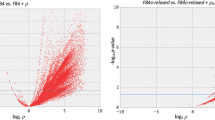Summary
Analysis of the rate of nucleotide substitution at silent sites inDrosophila genes reveals three main points. First, the silent rate varies (by a factor of two) among nuclear genes; it is inversely related to the degree of codon usage bias, and so selection among synonymous codons appears to constrain the rate of silent substitution in some genes. Second, mitochondrial genes may have evolved only as fast as nuclear genes with weak codon usage bias (and two times faster than nuclear genes with high codon usage bias); this is quite different from the situation in mammals where mitochondrial genes evolve approximately 5–10 times faster than nuclear genes. Third, the absolute rate of substitution at silent sites in nuclear genes inDrosophila is about three times hihger than the average silent rate in mammals.
Similar content being viewed by others
References
Aguade M (1988) Nucleotide sequence comparison of therp49 gene region betweenDrosophila subobscura andD. melanogaster. Mol Biol Evol 5:433–441
Anderson S, Bankier AT, Barrell BG, de Bruijn MHL, Coulson AR, Drouin J, Eperon IC, Nierlich DP, Roe BA, Sanger F, Schreier PH, Smith AJH, Staden R, Young IG (1981) Sequence and organization of the human mitochondrial genome. Nature 290:457–465
Beverley SM, Wilson AC (1984) Molecular evolution inDrosophila and the higher Diptera II. A time scale for fly evolution. J Mol Evol 21:1–13
Blackman RK, Meselson M (1986) Interspecific nucleotide sequence comparisons used to identify regulatory and structural features of theDrosophila hsp82 gene. J Mol Biol 188:499–515
Bodmer M, Ashburner M (1984) Conservation and change in the DNA sequences coding for alcohol dehydrogenase in sibling species ofDrosophila. Nature 309:425–430
Britten RJ (1986) Rates of DNA sequence evolution differ between taxonomic groups. Science 231:1393–1398
Brown WM, Prager EM, Wang A, Wilson AC (1982) Mitochondrial DNA sequences of primates: tempo and mode of evolution. J Mol Evol 18:225–239
Caccone A, Amato GD, Powell JR (1988a) Rates and patterns of scnDNA and mtDNA divergence within theDrosophila melanogaster subgroup. Genetics 118:671–683
Caccone A, DeSalle R, Powell JR (1988b) Calibration of the change in thermal stability of DNA duplexes and degree of base pair mismatch. J Mol Evol 27:212–216
Clary DO, Wolstenholme DR (1985) The mitochondrial DNA molecule ofDrosophila yakuba: nucleotide sequence, gene organization, and genetic code. J Mol Evol 22:252–271
Cohn VH, Moore GP (1988) Organization and evolution of the alcohol dehydrogenase gene inDrosophila. Mol Biol Evol 5: 154–166
de Bruijn MHL (1983)Drosophila melanogaster mitochondrial DNA: a novel organization and genetic code. Nature 304:234–241
DeSalle R, Freedman T, Prager EM, Wilson AC (1987) Tempo and mode of sequence evolution in mitochondrial DNA of HawaiianDrosophila. J Mol Evol 26:157–164
Henikoff S, Eghtedarzadeh MK (1987) Conserved arrangement of nested genes at the DrosophilaGart locus. Genetics 117:711–725
Henikoff S, Keene MA, Fechtel K, Fristrom JW (1986) Gene within a gene: nestedDrosophila genes encode unrelated proteins on opposite DNA strands. Cell 44:33–42
Ingolia TD, Craig EA (1982)Drosophila gene related to the major heat shock-induced gene is transcribed at normal temperatures and not induced by heat shock. Proc Natl Acad Sci USA 79:525–529
Keith TP, Riley MA, Kreitman M, Lewontin RC, Curtis D, Chambers G (1987) Sequence of the structural gene for xanthine dehydrogenase (rosy locus) inDrosophila melanogaster. Genetics 116:67–73
Kreitman M (1983) Nucleotide polymorphism at the alcohol dehydrogenase locus ofDrosophila melanogaster. Nature 304:412–417
Lee CS, Curtis D, McCarron M, Love C, Gray M, Bender W, Chovnick A (1987) Mutations affecting expression of therosy locus inDrosophila melanogaster. Genetics 116:55–66
Lemeunier F, David JR, Tsacas L, Ashburner M (1986) Themelanogaster species group. In: Ashburner M, Carson HL, Thompson JN (eds) The genetics and biology ofDrosophila, vol 3e. Academic Press, New York, pp 147–256
Li W-H, Wu C-I, Luo C-C (1985) A new method for estimating synonymous and nonsynonymous rates of nucleotide substitution considering the relative likelihood of nucleotide and codon changes. Mol Biol Evol 2:150–174
Li W-H, Tanimura M, Sharp PM (1987) An evaluation of the molecular clock hypothesis using mammalian DNA sequences. J Mol Evol 25:330–342
Martinez-Cruzado JC, Swimmer C, Fenerjian MG, Kafatos FC (1988) Evolution of the autosomal chorion locus inDrosophila. I. General organization of the locus and sequence comparisons of geness15 ands19 in evolutionarily distant species. Genetics 119:663–677
Moriyama E (1987) Higher rates of nucleotide substitution inDrosophila than in mammals. Jpn J Genet 62:139
Ochman H, Wilson AC (1987) Evolution in bacteria: evidence for a universal substitution rate in cellular genomes. J Mol Evol 26:74–86
Powell JR, Caccone A, Amato GD, Yoon C (1986) Rates of nucleotide substitution inDrosophila mitochondrial DNA and nuclear DNA are similar. Proc Natl Acad Sci USA 83:9090–9093
Riley MA (1989) Nucleotide sequence of theXdh region inDrosophila pseudoobscura and an analysis of the evolution of synonymous codons. Mol Biol Evol 6:33–52
Satta Y, Ishiwa H, Chigusa SI (1987) Analysis of nucleotide substitutions of mitochondrial DNAs inDrosophila melanogaster and its sibling species. Mol Biol Evol 4:638–650
Schaeffer SW, Aquadro CF (1987) Nucleotide sequence of theAdh gene region ofDrosophila pseudoobscura; evolutionary change and evidence for an ancient gene duplication. Genetics 117:61–73
Shields DC, Sharp PM, Higgins DG, Wright F (1988) “Silent” sites inDrosophila genes are not neutral: evidence of selection among synonymous codons. Mol Biol Evol 5:704–716
Solignac M, Monnerot M, Mounolou J-C (1986) Mitochondrial DNA evolution in themelanogaster species subgroup ofDrosophila. J Mol Evol 23:31–40
Throckmorton LH (1975) The phylogeny, ecology and geography ofDrosophila. In: King RC (ed) Handbook of genetics, vol 3. Plenum Press, New York, pp 421–469
Wienzierl R, Axton JM, Ghysen A, Akam M (1987)Ultrabithorax mutations in constant and variable regions of the protein coding sequence. Genes Devel 1:386–397
Wilde CD, Akam M (1987) Conserved sequence elements in the 5′ region of theUltrabithorax transcription unit. EMBO J 6:1393–1401
Wong Y-C, Pustell J, Spoerel N, Kafatos FC (1985) Coding and potential regulatory sequences of a cluster of chorion genes inDrosophila melanogaster. Chromosoma 92:124–135
Author information
Authors and Affiliations
Rights and permissions
About this article
Cite this article
Sharp, P.M., Li, WH. On the rate of DNA sequence evolution inDrosophila . J Mol Evol 28, 398–402 (1989). https://doi.org/10.1007/BF02603075
Received:
Revised:
Issue Date:
DOI: https://doi.org/10.1007/BF02603075




